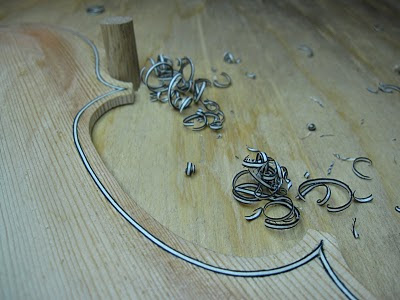"All that is very well," answered Candide, "but let us cultivate our garden."--Voltaire.
It’s probably pretty evident that I like my garden. I spend a fair amount of time on it; I enrich the soil with chicken poop and organics and adjust our cranky old watering system to favor the plants that I like. I spend a lot of time weeding and mulching to eradicate the plants I don’t like. I will even resort to biological and chemical warfare—iron phosphate, BT, copper strips and savage chickens—to discourage snails. All this is to make conditions just right for the relatively few species that I desire, which feed me and enrich my senses.
My plants think I am a sucker. I think I’m cultivating them so that I can use them. But they, to turn over a new leaf, think that they have got me very well trained to ensure the survival of their genomes. Really, since the meaning of life from a biological point of view is to make sure that your genes make it to the next generation, I am a thrall to my plants. However, just as I work to cultivate my plants, they work to cultivate me. They use sun, air, and their considerable chemical skill to make the sugars and flavones and pigments I crave. By doing this, they guarantee their survival instead of the triumph of the weeds. This isn’t really a new perspective—Michael Pollan wrote a book about it called “The Botany of Desire,” and the idea predates him by a long time. My garden reminds me that it’s possible for each partner in a relationship to be utterly selfish, and yet both will win.
All of us, from nomadic herders to suburban gardeners to skyscraper-dwelling urbanites, cultivate a secret, inner garden, and our relationship with its flora is even more complicated, beneficial, and dominated by selfishness than my personal relationship with sugar snap peas. Our gardens are what physicians call the “intestinal flora,” the squillions of microbes that live in our gut. We’re just now beginning to appreciate some of the complexity of this relationship, but it’s clear that each of us—microbe and human—is cultivating the other for our own selfish ends.
The simplest aspect of this relationship is digestive. We feed the microbes in our gut lots of polysaccharides (complex chains of simple sugars) and other stuff. Every different polysaccharide requires a unique enzyme to break it down, and we simply don’t have a big enough toolbox of enzymes to cope with all that we eat. But the microbes in our gut have thousands more such enzymes, and they can trim pretty much any polysaccharide into simple sugars; they then ferment these sugars, and get enough energy to live. They win. But we win too—the end products of these fermentations are things like alcohol and acetic acid, stuff that our cells are really good at using for fuel. So, we win. Or, as Reuben Bolling has it:

 When I cultivate my plants, I cause the plants that benefit me to grow more healthily, and reduce the fitness of those I don’t want. Specific bacteria also cultivate us; those individual mammals (the experiment has only been done on mice, for ethical reasons) who are not hospitable to certain bacteria are noticeably unhealthy. So, it could be argued that the Bacteria are cultivating—causing to grow more healthily—only those mammals that benefit them.
When I cultivate my plants, I cause the plants that benefit me to grow more healthily, and reduce the fitness of those I don’t want. Specific bacteria also cultivate us; those individual mammals (the experiment has only been done on mice, for ethical reasons) who are not hospitable to certain bacteria are noticeably unhealthy. So, it could be argued that the Bacteria are cultivating—causing to grow more healthily—only those mammals that benefit them.
We are very picky about the types of microbes that we cultivate—not just any bug will do. The wrong bacteria in your gut (or not enough of the right bacteria), is far worse for your health than too many dandelions in the garden. Most of the trillions of Bacterial cells in our intestines are of a handful of types in a well-regulated ratio, and a recent study by Andrew Gerwitz at Emory University suggests a mechanism by which we cultivate the right Bacteria.
Humans are increasingly plagued by “diseases of affluence” such as metabolic syndrome. Metabolic syndrome is a constellation of woes including type II diabetes, obesity, colon inflammation, hyperglycemia, irritable bowel syndrome, and on and on. Some of this is obviously due to lifestyle. However, genetics plays a role, as it is possible to find mice that are genetically predisposed to something that looks an awful lot like metabolic syndrome. These unfortunate mice are obese, hyperglycemic, hypertensive, insulin-resistant, given to overeating, and prone to all manner of inflammatory diseases. Not to be gross, but they are really different looking inside. The one on the right, with visibly more fat and inflamed colon and liver, is the mutant mouse:

It is not certain that these mice have the exact same thing as human metabolic syndrome, but it has all the hallmarks. As with humans, you can even make them much healthier by putting them on a restricted diet.
All the differences visible in the picture there, plus hypertension, insulin resistance and more are due to a single genetic defect. They are missing one gene, called TLR 5. So, how can the loss of one gene cause such multifarious misery? The TLR 5 gene encodes a protein that sits on the surface of the cells that line our intestines. This protein is similar to a class of proteins that are receptors for specific bacterial proteins—that is, they grab onto these proteins (which are presumably attached to bacteria), and hold on to them tightly. It made sense, then, for Gerwitz’s co-workers to look for differences in the intestinal flora between mice that had the TLR 5 gene and those that lacked it.
Mice, like humans, are born with a clean slate as far as intestinal flora are concerned. We both are rapidly colonized by a diverse array of bacteria and other microbes off of our mothers’ skin (and all the other stuff any baby will put in its mouth. I once made the mistake of talking about this with the mother of a newborn. It was not something she wished to think about.). So, a lot of what defines the cast of characters in our intestinal flora is what is in our environment.
But genetics matters too. Gerwitz used an embryo transplantation to put both fetal mice with TLR 5 and fetal mice without TLR 5 in the same mama mouse. The normal and mutant mice were born and raised together, with the normal mice turning out normal and the mutant mice looking like the stereotypical ugly American. Comparison of the bacteria living in their guts showed that the main difference was not what types of bacteria were present, but that some were much more prevalent in one or the other. The obese mice were especially lacking in some of the Bacteroides, the same ones that are helping to save Billy Dare. What’s worse, Gerwitz found that he could mostly sterilize the intestines of a normal mouse with antibiotics, then re-colonize it with bacteria from one of the mutant mice (I won’t go into methods here, but if you’ve seen the movie Pink Flamingos, you’ll know how it was done). The genetically normal mice with the altered gut bacteria developed all the ills of their mutant littermates. So not only was there a correlation between altered intestinal flora and metabolic syndrome, there is pretty clear causation.
We still don’t know the exact mechanism by which the wrong intestinal flora leads to metabolic syndrome, or indeed whether exactly the same thing happens in humans with this disease. However, it is known that many of the “good” intestinal bacteria produce a variety of chemicals that, in effect, soothe a rowdy immune system. Without this check, our immune system can attack our own cells, causing inflammation in the gut and killing cells that should be responding to insulin—both features if metabolic syndrome. It appears that mice have the gene TLR 5 mainly so that they can keep the “good” intestinal bacteria around—in effect, cultivating the right cells in their intestinal flora, and suppressing autoimmune reactions. A mutation eliminating TLR 5 means that the “good” bacteria are eliminated, and others take their place. These bacteria can’t pacify the immune system, and autoimmune attacks lead to metabolic syndrome.
All animals evolved in a world dominated by microbes—they are, and always have been, as much a part of the environment as air and water. From an evolutionary point of view, it is impossible to say just who is cultivating whom, and this study makes it clear that the answer ultimately doesn’t really matter. We mammals go to the trouble of having and expressing specific genes such as TLR 5 so that we may cultivate certain species of Bacteria. We do this, because if we did not, we would be unhealthy. Conversely, Bacteroides goes to the trouble of having and expressing specific genes so that it may improve the health of its mammalian host. It does this, because if it did not, it would be kicked off the gravy train flowing through our gut. Like me and my heirloom purple pole beans, it’s a relationship in which we both win by being selfish.
Matam Vijay-Kumar, Jesse D. Aitken, Frederic A. Carvalho, Tyler C. Cullender, Simon Mwangi, Shanthi Srinivasan, Shanthi V. Sitaraman, Rob Knight, Ruth E. Ley, Andrew T. Gewirtz (2010). Metabolic Syndrome and AlteredGut Microbiota in Mice Lacking Toll-Like Receptor. Science 328, 228-231.
































